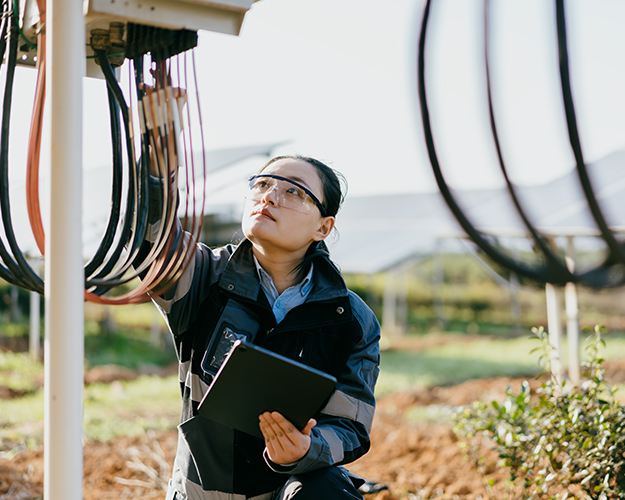Key Takeaways
- The Inflation Reduction Act establishes new requirements for the Section 45 renewable electricity production credit.
- The credit is based on kilowatt hours produced by a qualifying facility and sold to an unrelated party.
- Additional bonus amounts are available for satisfying prevailing wage and apprenticeship rules, constructing with domestic content, and being in energy communities.
The Inflation Reduction Act introduced new updates to Section 45, the renewable electricity production tax credit. Here’s what you need to know to make the most of this credit enhancement.
What is the Section 45 Credit?
Section 45 is a Production Tax Credit (PTC) for producing and selling renewable electricity.
The credit reduces a taxpayer’s federal tax liability by .3 cents ($.003) per kilowatt hour produced by the taxpayer. For tax years beginning after December 31, 2022, exempt organizations are eligible to participate and receive “direct pay” under Section 6417.
Qualifying electricity production for Section 45 includes:
- Wind
- Biomass
- Geothermal
- Solar
- Small irrigation
- Landfill and trash
- Hydropower
- Marine and hydrokinetic
Increased Credit Amount for Section 45
There are several ways to increase the amount of the Section 45 Credit.
Prevailing Wage and Apprenticeship Requirements
A bonus credit rate of five times the allowable rate can be reached for a maximum of 1.5 cents per kilowatt hour if you meet any of the following:
- Recordkeeping and reporting requirements must be met for the construction project and the 10-year period beginning when the project is placed in service. Requirements are similar to the Davis-Bacon Act, with less frequent record submissions.
- Construction of the qualified facility begins before January 29, 2023.
- A qualified facility has a maximum net output of less than 1 megawatt.
Domestic Content
Suppose domestic content rules are satisfied by a qualified renewable electricity production facility placed in service after December 31, 2022. In that case, the credit amount is increased by 10% of the base or increased credit amount.
Energy Communities
If the qualified facility is located in an energy community, the credit amount is increased by 10%. The “located in” requirement can be satisfied by either the Nameplate Capacity Test, the Footprint Test, or the Brownfield Site safe harbor. See Notice 2023-29 for further details.
Reduction to the Section 45 Credit
There are a variety of situations that may result in reduction to the Section 45 Credit.
Increased Electricity Prices
In situations where the annual average contract price is in excess of an IRS-designated amount, the allowable credit will be reduced by a specified ratio.
Tax-Exempt Bond Financing
The credit may be reduced for tax-exempt bond financing. The reduction amount equals the otherwise allowable credit multiplied by the lesser of:
- 15%
- The reduction fraction, which is the sum of proceeds for the current tax year and prior years on an obligation in which the interest is exempt from tax under Section 103 and which is used to provide financing for the qualified facility, divided by the aggregate amount of additions to the capital project for the taxable year and all prior taxable years.
Partial Credit Facilities
For the following facilities in service in 2023 or later, the renewable electricity credit is reduced by one-half:
- Open-loop Biomass Facility
- Small Irrigation Power Facility
- Landfill Gas Facility
- Trash Facility
For facilities in service before 2023, certain reductions also exist.
Phase Out of Section 45
For projects with construction beginning after December 31, 2021 (January 1, 2025, for property using fiber-optic distributed sunlight) and prior to January 1, 2025, organizations should use the Inflation Reduction Act provisions.
The Section 45 credit begins to phase out through December 31, 2034. A similar provision, Section 45Y, takes the place of Section 45 for construction beginning after December 31, 2024.
Elective Payment Phase Out
Beginning after 2024, taxpayers electing the direct payment election under Section 6417 have a 10% reduction in credit amount if domestic content rules are not satisfied. The domestic content rules require that any steel, iron, or manufactured product be produced in the United States.
An exception to this reduction is allowed if using U.S. produced steel, iron, or manufactured products increasing the overall costs of construction by more than 25%. Another exception exists if relevant steel, iron, or manufactured products are not produced in the United States in sufficient and reasonably available quantities or of satisfactory quality.
Section 45 in Action: A Wind Facility Example
A wind facility was placed in service in November 2023. The employer pays union rates. This means the facility meets prevailing wages, and it uses qualified apprentices. Domestic content was used for the construction of the facility, located in an energy community. In 2024, the facility produced and sold 500,000,000 kilowatts of energy.
For 2024, their Section 45 credit value will be:
| Rate | Total | |
|---|---|---|
| Base Credit | .003 | $ 1,500,000 |
| Partial Credit Facility | 50% | ($ 600,000) |
| Subtotal | $900,000 | |
| Prevailing Wage & Apprentice | 5X | $ 4,500,000 |
| Domestic Content | 10% | $ 450,000 |
| Energy Community | 10% | $ 450,000 |
| Total Credit | $ 5,400,000 |
What Organization Can Do Next With Section 45
The Inflation Reduction Act provided several new or enhanced business credits and incentives for exempt and for-profit organizations to utilize as tax savings. As you consider clean energy projects or updates to your facilities, be sure to work alongside a trusted energy services provider.
How the Inflation Reduction Act enhances energy efficient opportunities.
 Read the Article
Read the ArticleBusiness Credits & Incentives
Benefit from available tax credits and deductions to help maximize tax savings.
Who We Are
Eide Bailly is a CPA and business advisory firm helping our clients grow, thrive, and embrace opportunities and innovation.



